Uncover the layered significance of bullocks in the Bible, exploring their sacrificial role and symbolic meaning.
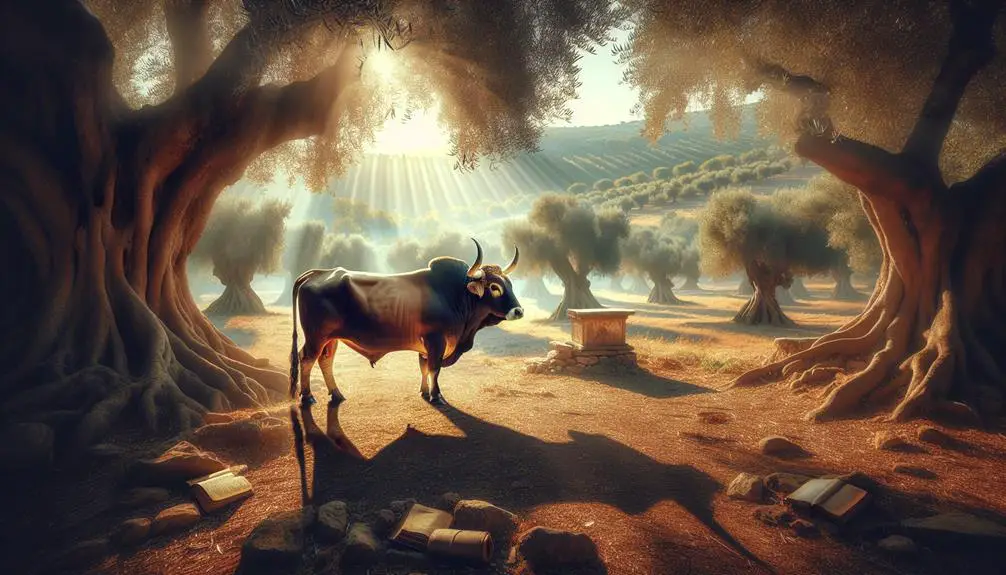
Bullock Definition in the Bible
You might think the term 'bullock' in the Bible simply refers to a young bull, but it's layered with deeper significance that extends beyond its basic definition. As you explore the historical context, the role of bullocks in sacrificial rites, and their symbolism in scripture, you'll uncover how these animals were not only central to ancient practices but also carried metaphorical weight.
The way bullocks are woven into literary references throughout the Bible offers insights into contemporary interpretations, challenging you to consider how these ancient texts remain relevant. Let's embark on a journey to uncover the multifaceted role of bullocks in biblical times and what they symbolize for us today.
Key Takeaways
- Bullocks in the Bible symbolize strength, sacrifice, and servitude, reflecting their crucial role in ancient religious practices.
- Their sacrifice is often associated with atonement, covenant, and redemption, underscoring their spiritual and symbolic significance.
- The metaphorical use of bullocks enriches biblical narratives, conveying complex ideas of devotion and divine interaction.
- Contemporary interpretations of bullocks in the Bible re-evaluate their symbolism, offering insights into spiritual truths and moral teachings.
Historical Context of Bullock
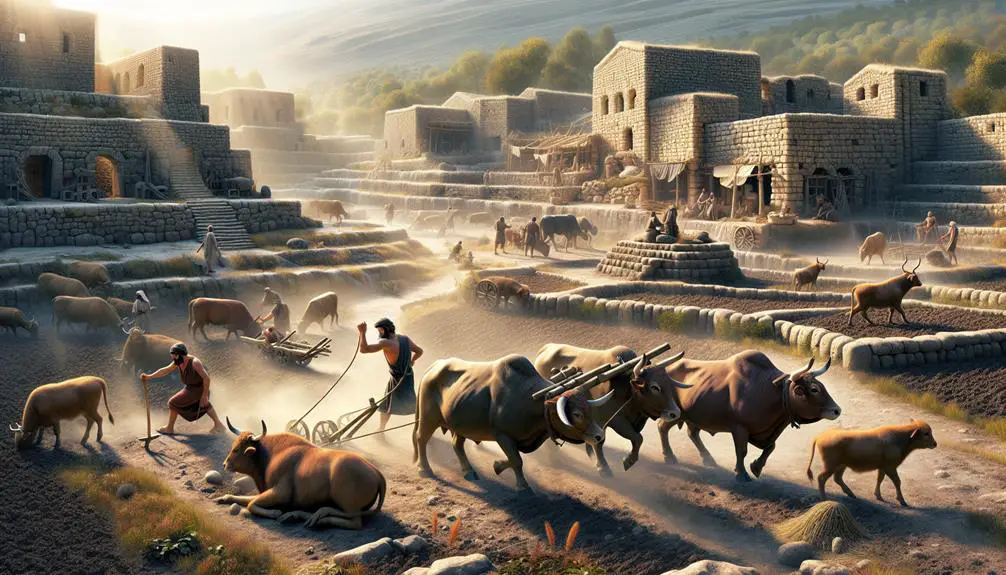
In exploring the historical context of the term 'bullock' within biblical scripture, it's crucial to recognize its significance as a symbol of sacrifice and agricultural wealth in ancient societies. The reliance on bullocks, primarily as draft animals and sources of sustenance, underscores the intricate relationship between animal husbandry and agricultural practices in these communities.
You'll find that the management of bullocks was central to the advancement of agriculture. These animals played a pivotal role in tilling the land, significantly increasing the productivity and efficiency of farming. Their strength and endurance were vital in an era when mechanical tools were nonexistent, making them indispensable assets.
Moreover, the breeding and care of bullocks were sophisticated forms of animal husbandry, reflecting a deep understanding of genetics, nutrition, and animal welfare. This expertise ensured that the strongest and healthiest animals contributed to both the field and the future generations, enhancing the sustainability of agricultural practices.
The economic implications of bullocks in ancient societies can't be overstated. Owning a bullock was a sign of wealth and status, as it directly correlated to the ability to cultivate more land and, consequently, produce more crops. This agricultural prosperity was foundational to the growth and stability of communities, influencing social structures and trade.
Bullock in Sacrificial Rites
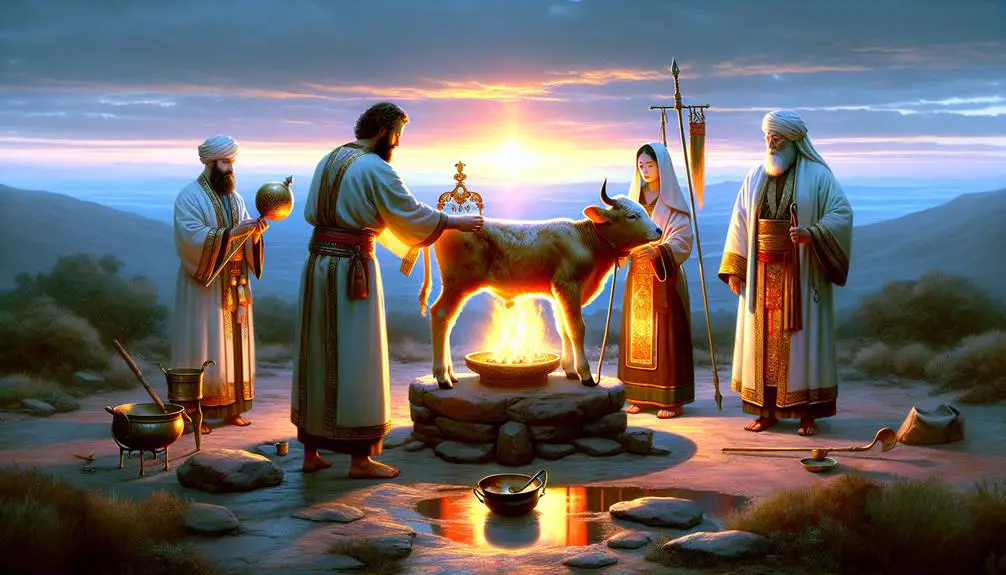
Throughout ancient religious practices, the bullock served as a central figure in sacrificial rites, embodying a profound spiritual and communal significance. This practice, deeply rooted in the ancient Near Eastern cultural milieu, found its expression in various forms across different civilizations, including those that influenced the biblical narratives. You'll notice that the meticulous attention to ritual purity and offering procedures underscores the sanctity and solemnity of these rites.
The biblical injunctions regarding sacrificial offerings, particularly those involving bullocks, are detailed and precise, highlighting the importance of adhering to divinely ordained protocols. These protocols served not only as a means to maintain ritual purity but also to foster a sense of communal identity and continuity. You find that the ritual slaughter, preparation, and offering of bullocks were conducted with the utmost care, ensuring that every step, from selection to sacrifice, conformed to the established religious norms.
In examining these rites, it's crucial to understand the role of the bullock not merely as a sacrificial animal but as a symbolic vessel through which practitioners sought to achieve atonement, express devotion, and maintain the covenantal relationship with the divine. The offering procedures, intricate and codified, reflect a theology that places significant emphasis on the concepts of purity, redemption, and divine appeasement.
As you delve deeper into the textual and archaeological evidence, you uncover a complex tapestry of religious expression, where the bullock emerges as a key player in the spiritual economy of ancient Near Eastern societies. This analysis allows you to appreciate the bullock's role in sacrificial rites as a multifaceted symbol of religious devotion, community solidarity, and spiritual aspiration.
Symbolism and Metaphors
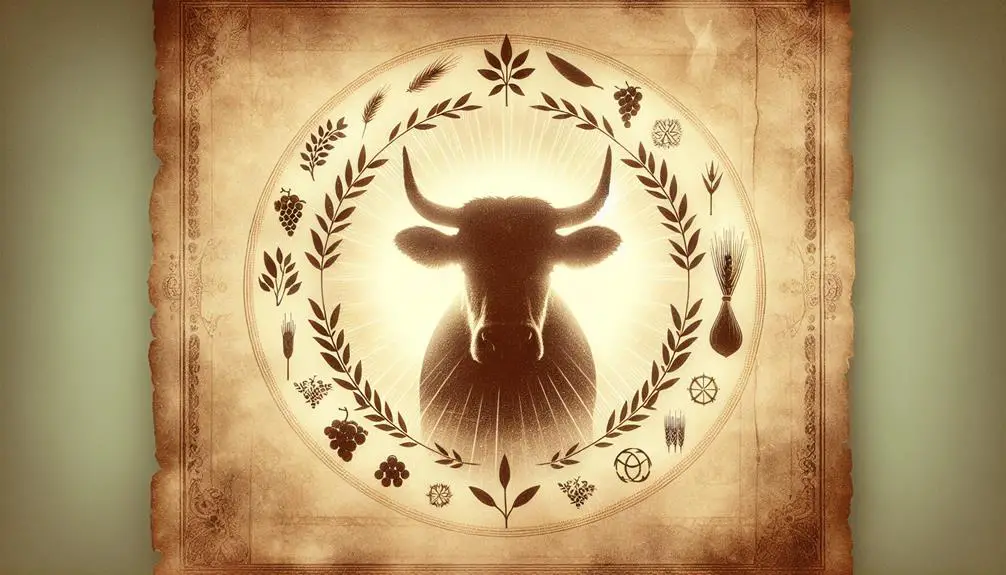
Moving beyond the physical rites, the symbolism and metaphors associated with bullocks in the Bible offer deep insights into spiritual truths and moral teachings. The biblical references to bullocks are rich with layers of meaning that extend beyond their immediate context, shedding light on the values and beliefs of ancient societies. By examining the animal traits and cultural significance of the bullock, one can uncover a profound understanding of the metaphorical language used in the scriptures.
Symbolism |
Animal Traits |
Cultural Significance |
|---|---|---|
Strength |
Physical power and endurance |
Valor and resilience in facing life's challenges |
Sacrifice |
Utility in agriculture and religious rites |
Surrender and devotion to higher principles |
Fertility |
Reproductive capabilities |
Abundance and prosperity within the community |
The bullock's physical prowess and endurance symbolize strength, a virtue highly esteemed in biblical narratives. This strength is not merely physical but also represents the spiritual and moral fortitude required to uphold one's faith and integrity amidst adversity.
Furthermore, the bullock's role in sacrificial rites highlights the profound concept of sacrifice. This animal's utility, both in agriculture and religious practices, underscores the theme of surrendering one's most valued possessions for a greater purpose, embodying devotion and commitment to divine principles.
Lastly, the fertility associated with bullocks speaks to themes of abundance and prosperity. This symbolism extends beyond material wealth, encompassing spiritual growth and the flourishing of a community bound by shared values and beliefs. Through these metaphors, the biblical texts convey timeless lessons on strength, sacrifice, and prosperity, deeply rooted in the animal traits and cultural significance of the bullock.
Literary References in Scripture
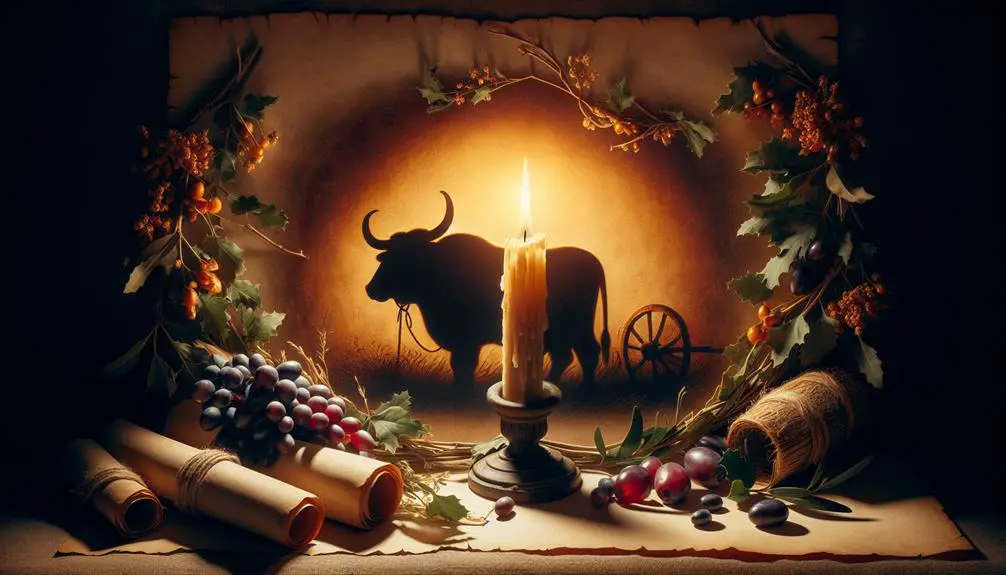
Numerous passages within the Bible utilize bullocks as key elements in literary constructs, offering profound insights into theological and moral principles. You'll find that these references aren't merely incidental but serve as potent narrative devices and animal imagery, deeply embedded in the fabric of biblical storytelling. They enhance the narrative's texture and depth, providing layers of meaning that extend beyond the literal.
Analyzing these literary references, you'll notice that bullocks often symbolize strength, sacrifice, and servitude. They're integral parts of the stories, parables, and prophetic visions, grounding the ethereal messages of the scripture in the tangible and familiar world of agrarian society. This choice of imagery isn't accidental. It reflects a deliberate effort to communicate complex ideas in a form that's accessible to the scripture's original audience, many of whom would have been intimately familiar with the care and value of bullocks in their daily lives.
Moreover, the use of bullocks in these narratives isn't just about symbolism. It also functions as a narrative device that propels the story forward or deepens the reader's understanding of a character's motivations or the gravity of a situation. For instance, the sacrifice of a bullock often signifies a moment of profound spiritual significance, underscoring themes of atonement, covenant, and redemption.
Through this lens, you'll appreciate how these literary references to bullocks aren't merely decorative or incidental. Instead, they're meticulously woven into the scripture's narrative structure, enhancing its ability to convey complex theological and moral teachings in a relatable and impactful manner.
Contemporary Interpretations
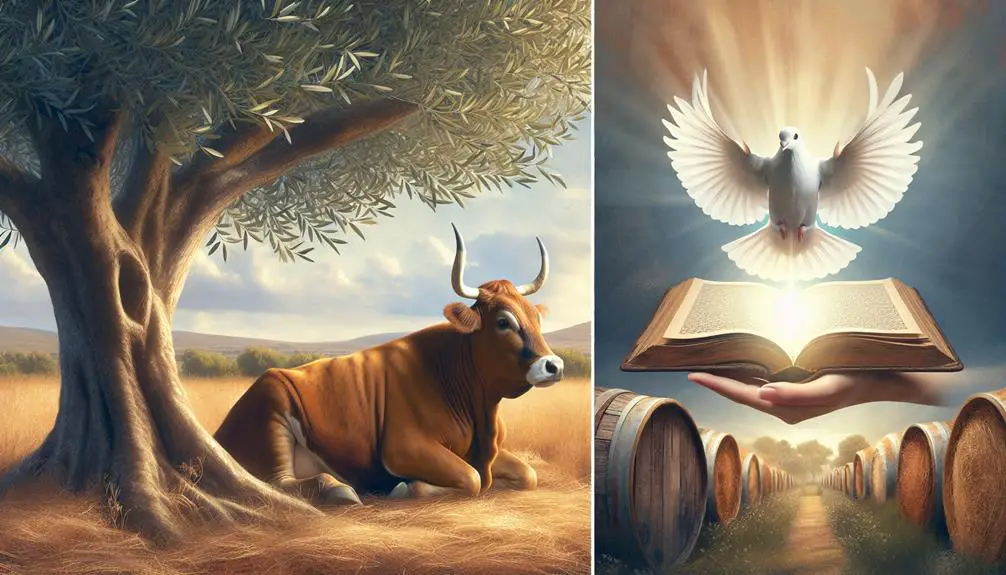
In contemporary interpretations, scholars often re-evaluate the symbolism of bullocks in biblical narratives, considering cultural and historical shifts in understanding these ancient texts. You'll find that modern perceptions of these symbols diverge significantly from their original contexts, influenced by evolving theological debates and scholarly insights. This reevaluation illuminates the multifaceted roles bullocks played, not just in rituals and sacrifices, but also in representing wealth, power, and divine favor.
Historically, bullocks were seen as valuable sacrificial animals, integral to ancient Near Eastern religious practices. However, your understanding of their significance today might hinge more on metaphorical interpretations, reflecting broader themes of sacrifice, devotion, and atonement in a contemporary religious context. Scholars dissect these layers, debating their relevance and application in modern faith communities.
Theological debates further complicate these interpretations. Some argue that viewing bullocks merely as historical artifacts of ancient worship practices misses the deeper, enduring spiritual lessons they embody. Others contend that modern believers must transcend literal interpretations to grasp the symbolic meanings relevant to today's ethical and spiritual dilemmas.
You're invited to navigate these discussions, considering how contemporary insights into biblical bullocks can inform your understanding of scripture and spirituality. This analytical journey not only deepens your appreciation of biblical symbolism but also challenges you to reflect on how ancient wisdom can address modern existential questions. Through this lens, the biblical bullock transcends its historical context, offering timeless insights into human nature, divine interaction, and the pursuit of holiness.
Frequently Asked Questions
How Do Modern Farming Practices Compare to the Biblical Methods of Raising Bullocks?
Modern farming practices have dramatically evolved from biblical times, incorporating genetic modifications and technological advancements. You'll find that animals are often bred for specific traits, aiming for increased productivity and resistance to diseases.
Technological advancements have revolutionized care and feeding, making it far more efficient than the methods mentioned in historical texts.
This evolution reflects a shift towards maximizing output and efficiency, contrasting sharply with the more naturalistic and manual approach of the past.
Are There Specific Breeds of Cattle Today That Can Be Directly Traced Back to the Bullocks Mentioned in the Bible?
You're looking at whether today's cattle breeds have a direct genetic link to ancient bullocks. While pinpointing specific breeds is challenging, genetic ancestry studies and historical depictions suggest a connection.
What Are the Environmental Impacts of Bullock Farming in Ancient Times Versus Today?
You're navigating a sea of complexity when comparing the environmental impacts of ancient versus modern bullock farming.
Ancient practices barely scratched the surface of climate change and soil degradation, thanks to lower population densities and less intensive farming methods. Today, however, bullock farming contributes significantly to both issues, as industrial-scale agriculture accelerates soil degradation and boosts greenhouse gas emissions, intensifying the challenge of climate change.
It's a stark contrast that reflects broader shifts in agricultural practices.
How Has the Dietary Significance of Bullocks Changed From Biblical Times to the Present Across Different Cultures?
You've noticed that the dietary significance of bullocks has evolved significantly from ancient times to the present across various cultures. Initially central to religious rituals, their role has shifted due to culinary evolution.
Today, while still important in some traditions, bullocks are more commonly seen as a source of nutrition rather than a sacred offering. This shift reflects broader changes in societal values and dietary practices, moving from strictly religious to more secular and practical considerations.
Can the Care and Treatment of Bullocks in Biblical Times Provide Insights Into the Ethical Considerations of Animal Husbandry in Contemporary Society?
Isn't it fascinating how ancient practices can enlighten today's ethical debates on animal care?
By examining the treatment of bullocks in biblical times, you uncover ethical parallels that challenge and enrich our understanding of modern stewardship.
This historical lens provides a unique perspective, compelling you to question and potentially refine current standards in animal husbandry.
It's a thoughtful journey from past to present, bridging gaps in our ethical considerations.
Conclusion
In conclusion, you've journeyed through the multifaceted role of the bullock in biblical narratives, from its historical context to its symbolic weight in sacrificial rites. This exploration has unveiled the bullock not just as an animal, but as a profound metaphor woven into the fabric of spiritual and cultural practices.
Through literary references, you've seen how it transcends time, even in today's digital age, reminding us of enduring themes of sacrifice and redemption. This analysis highlights the enduring relevance of ancient symbols in contemporary spiritual understanding.



Sign up